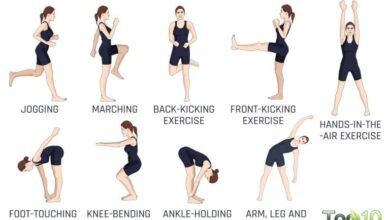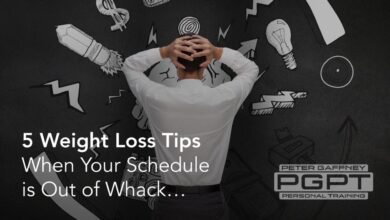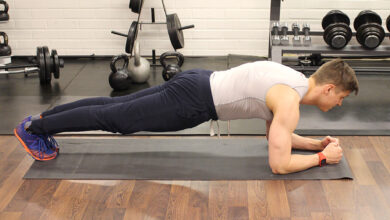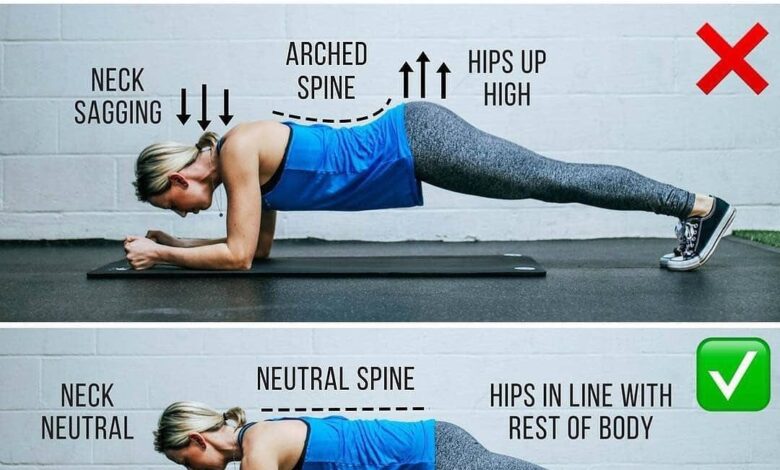
Plank Mistakes and How to Avoid Them: Master This Core Exercise
Plank mistakes and how to avoid them – it’s a topic that’s essential for anyone looking to build a strong core and improve their overall fitness. The plank is a seemingly simple exercise, but mastering proper form is crucial to reap its benefits and avoid potential injuries.
This article will guide you through the fundamentals of the plank, highlighting common mistakes and offering practical solutions to elevate your plank game.
We’ll delve into the benefits of the plank, explore the correct technique, and pinpoint the most frequent errors people make. From understanding the importance of engaging your core muscles to recognizing and correcting faulty form, this comprehensive guide will equip you with the knowledge to perform planks effectively and safely.
Understanding the Plank
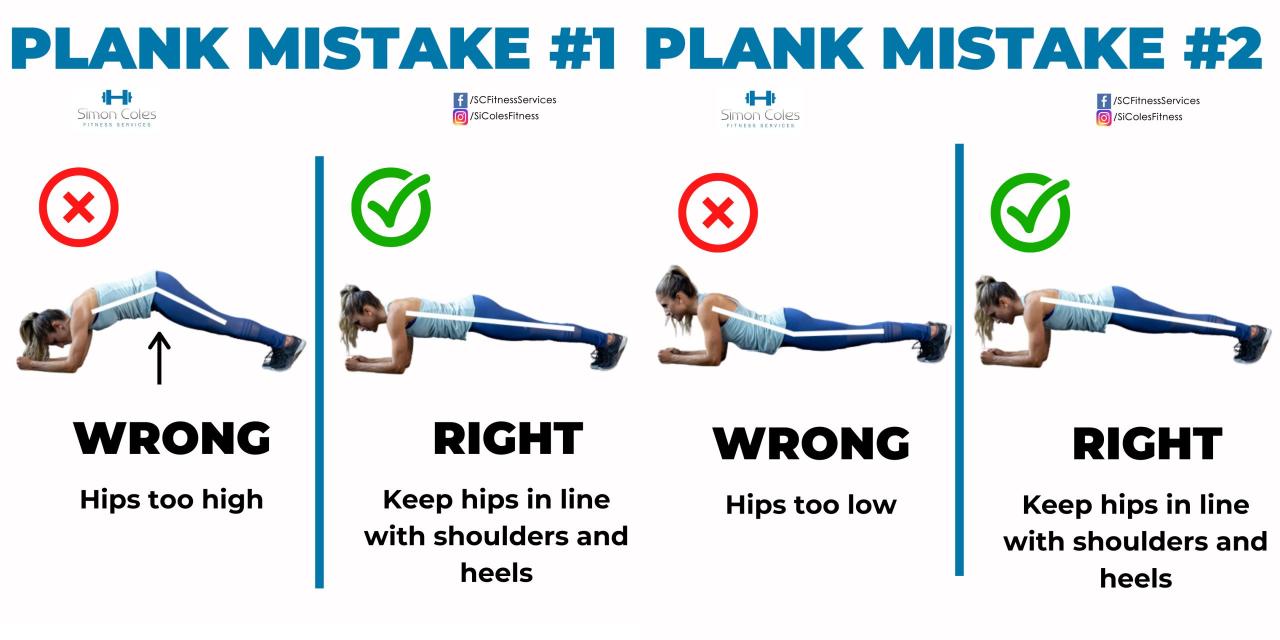
The plank is a deceptively simple exercise that engages multiple muscle groups, making it a highly effective core strengthener. It is a static exercise, meaning you hold a position for a period of time, unlike dynamic exercises that involve movement.
Mastering the plank isn’t just about holding a rigid pose for as long as possible. It’s about engaging your core muscles correctly, avoiding common mistakes like sagging hips or over-extending your neck. Just like hitting a weight loss plateau, it’s about understanding the nuances and making adjustments.
If you’re stuck in a rut with your plank progress, check out these 10 tips to overcome a weight loss plateau for some helpful strategies. The same principles of consistency, tweaking your approach, and pushing yourself gradually can apply to both weight loss and perfecting your plank form.
So, keep experimenting, stay motivated, and you’ll be holding that perfect plank in no time!
Beyond its simplicity, the plank offers a wide range of benefits for both your physical and mental well-being.
Benefits of the Plank
The plank exercise is a powerhouse for core strength and stability, but its benefits extend far beyond just a toned stomach. Here are some key benefits:
- Improved Core Strength and Stability:The plank directly targets your core muscles, including your abdominal muscles, obliques, lower back, and glutes. This enhanced core strength translates to improved posture, balance, and reduced risk of back injuries.
- Enhanced Functional Fitness:Many daily activities, like lifting heavy objects, require core strength and stability. The plank strengthens these muscles, improving your overall functional fitness and making everyday tasks easier.
- Reduced Risk of Back Pain:A strong core helps support your spine, reducing the risk of lower back pain. The plank is particularly effective in strengthening the muscles that stabilize your spine, reducing strain and pain.
- Improved Posture:A strong core helps maintain proper posture, preventing slouching and promoting a more upright stance. This not only enhances your appearance but also improves breathing and digestion.
- Increased Metabolism:While not a primary fat-burning exercise, the plank engages a large number of muscle groups, leading to increased calorie expenditure and potentially boosting your metabolism.
- Improved Balance and Coordination:The plank requires you to maintain a stable position, challenging your balance and coordination. This can help improve your overall agility and control.
Proper Plank Form and Technique
Maintaining proper form is crucial to maximize the benefits of the plank and avoid potential injuries. Here’s a step-by-step guide to achieve the correct form:
- Start in a Push-Up Position:Begin on your hands and toes, with your body in a straight line from head to heels. Your hands should be directly under your shoulders, and your forearms should be parallel to each other.
- Lower to Forearms:Slowly lower your body onto your forearms, keeping your elbows directly below your shoulders. Your forearms should be parallel to each other, and your hands should be shoulder-width apart.
- Engage Your Core:This is the most crucial step. Tighten your abdominal muscles, pulling your belly button towards your spine. This will help stabilize your core and prevent your hips from sagging or rising.
- Maintain a Straight Line:Ensure your body forms a straight line from your head to your heels. Your hips should not be higher or lower than your shoulders.
- Engage Your Glutes:Actively squeeze your glutes to further stabilize your core and prevent your hips from sagging.
- Maintain Neck Alignment:Keep your neck in a neutral position, in line with your spine. Avoid looking up or down, as this can strain your neck muscles.
- Hold the Position:Start with holding the plank for 10-30 seconds. Gradually increase the hold time as you get stronger.
- Focus on Proper Breathing:Breathe deeply and evenly throughout the exercise. Do not hold your breath.
Engaging the Core Muscles
The core is a complex group of muscles, and effectively engaging them during the plank is key to reaping its full benefits. Here’s how to ensure you’re maximizing your core engagement:
- Imagine Pulling Your Belly Button Towards Your Spine:This creates a natural inward pressure, engaging your abdominal muscles and tightening your core.
- Engage Your Glutes:Squeeze your glutes to further stabilize your core and prevent your hips from sagging.
- Avoid Holding Your Breath:Deep, controlled breathing helps maintain stability and prevents you from straining your core muscles.
- Focus on Proper Form:Maintaining a straight line from head to heels ensures your core muscles are working efficiently.
Common Plank Mistakes
Planking, despite its simple appearance, requires proper form to maximize its benefits and avoid potential injuries. While many people think they’re doing a plank correctly, common mistakes can hinder your progress and even lead to discomfort or pain. Understanding these mistakes and implementing corrections can significantly enhance your plank experience and ensure you’re getting the most out of this effective exercise.
Plank mistakes are common, but they’re easily avoided. One of the biggest mistakes is holding your breath, which can lead to muscle tension and even dizziness. Instead, focus on maintaining steady, controlled breathing throughout the hold. And if you’re finding your meal prep routine feels stale, check out these 6 proven ways to get out of a meal prep plateau – fresh ideas can keep your motivation high, just like a proper plank technique can help you reach your fitness goals.
Remember, a strong core is essential for a variety of exercises, so make sure you’re nailing your plank form for optimal results.
Common Plank Mistakes and Their Consequences
The plank, while seemingly straightforward, often harbors subtle mistakes that can compromise its effectiveness and potentially lead to injuries. Understanding these errors and their consequences is crucial for maximizing your plank experience and ensuring you’re getting the most out of this exercise.
Mastering the plank is all about proper form. Avoid sagging hips or arching your back, which can strain your muscles and limit effectiveness. Sometimes a change of scenery can work wonders for motivation, like the inspiring story of Charlotte, who lost half her body weight on a vacation – read more about it here.
Remember, consistent, proper form is key to reaping the benefits of the plank, so keep those core muscles engaged and watch your strength soar!
| Mistake | Description | Impact | Correction |
|---|---|---|---|
| Sagging Hips | The hips dip below the shoulder line, creating a V-shape in the body. | Reduced core engagement, increased strain on the lower back, and potential for injury. | Engage the glutes and abdominal muscles to lift the hips and maintain a straight line from head to heels. Imagine you are trying to draw your belly button towards your spine. |
| Rounding the Back | The spine curves excessively, leading to a hunching posture. | Reduced core engagement, increased strain on the lower back, and potential for neck pain. | Engage the abdominal muscles to flatten the back and maintain a neutral spine. Imagine you are trying to draw your belly button towards your spine. |
| Head Position | Looking up or down excessively can strain the neck and misalign the spine. | Neck pain, reduced core engagement, and potential for headaches. | Keep the head in line with the spine, looking straight ahead. Imagine you are trying to draw your belly button towards your spine. |
| Tight Shoulders | Tensing the shoulders and neck can lead to discomfort and reduced core engagement. | Neck and shoulder pain, decreased core activation, and potential for headaches. | Relax the shoulders and keep them away from the ears. Imagine you are trying to draw your belly button towards your spine. |
| Protruding Stomach | The stomach protrudes outward, indicating weak core engagement. | Reduced core engagement, increased strain on the lower back, and potential for injury. | Engage the abdominal muscles to draw the stomach in and maintain a flat, stable core. Imagine you are trying to draw your belly button towards your spine. |
| Unsupported Forearms | Forearms are not parallel to each other or not perpendicular to the floor, leading to uneven weight distribution. | Uneven weight distribution, potential for instability, and increased strain on wrists. | Ensure forearms are parallel to each other and perpendicular to the floor. |
Avoiding Plank Mistakes: Plank Mistakes And How To Avoid Them
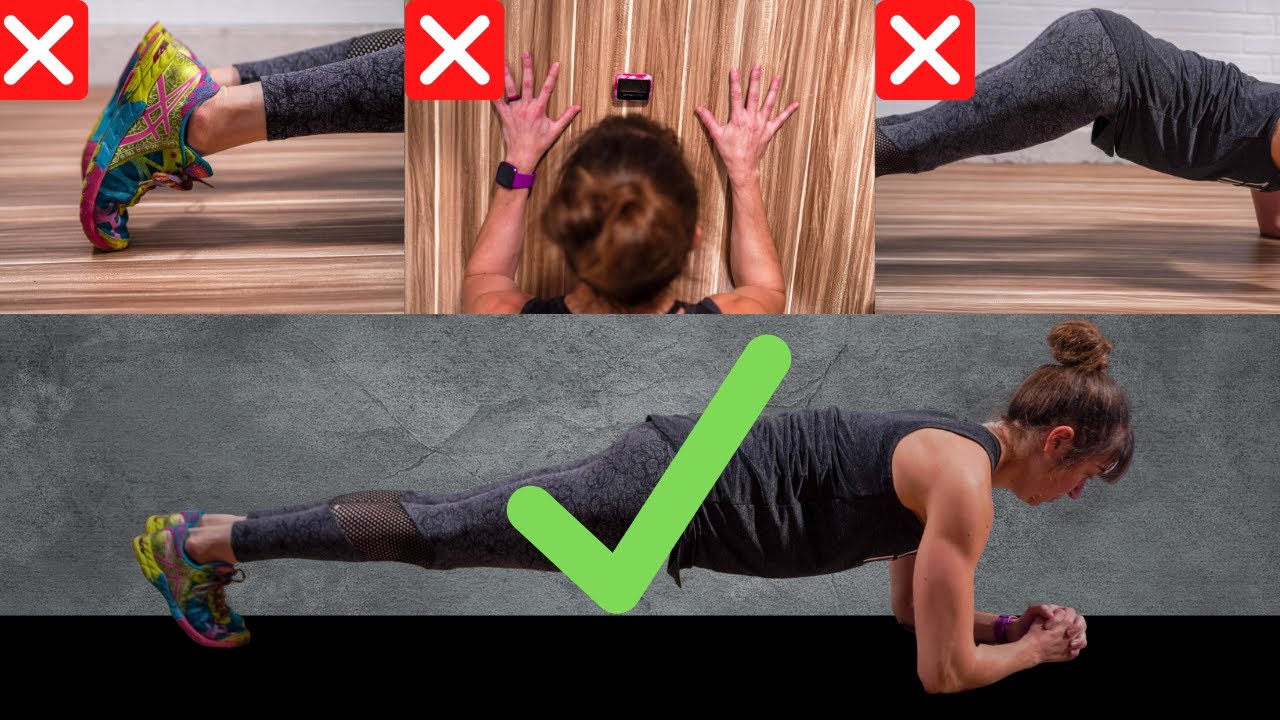
Now that we’ve covered the fundamentals of the plank and common errors, let’s dive into strategies for maintaining proper form and avoiding those pitfalls. By focusing on these tips, you can maximize the benefits of this exercise and minimize the risk of injury.
Preventing Common Plank Mistakes
Preventing common plank mistakes is crucial for maximizing the benefits of this exercise and minimizing the risk of injury. By following these tips, you can ensure you’re performing the plank correctly and reaping its full potential.
- Engage Your Core:The plank is a core-centric exercise, so it’s essential to engage your abdominal muscles throughout the hold. Imagine pulling your belly button towards your spine, tightening your core, and keeping your back flat.
- Maintain a Straight Line:From your head to your heels, your body should form a straight line. Avoid sagging in the middle or letting your hips rise.
- Keep Your Neck Neutral:Look straight down at the floor, avoiding tilting your head up or down. This helps maintain a neutral spine and prevents neck strain.
- Avoid Holding Your Breath:Breathe naturally throughout the plank. Holding your breath can restrict blood flow and lead to discomfort.
- Proper Hand Placement:Your hands should be directly beneath your shoulders, with your fingers pointing forward. This ensures proper alignment and stability.
- Engage Your Glutes:Actively squeeze your glutes throughout the plank. This helps stabilize your hips and prevents them from sagging.
Adjusting the Plank for Fitness Levels, Plank mistakes and how to avoid them
The plank can be modified to suit different fitness levels and limitations. Here are some adjustments to consider:
- Modified Plank on Knees:If you find the full plank challenging, start with a modified version on your knees. This reduces the strain on your wrists and core.
- Plank with Forearms on an Elevated Surface:For added challenge, elevate your forearms on a bench or box. This increases the range of motion and engages more muscles.
- Plank with a Stability Ball:Incorporating a stability ball into the plank adds an element of instability, requiring more core activation to maintain balance.
Plank Variations and Modifications
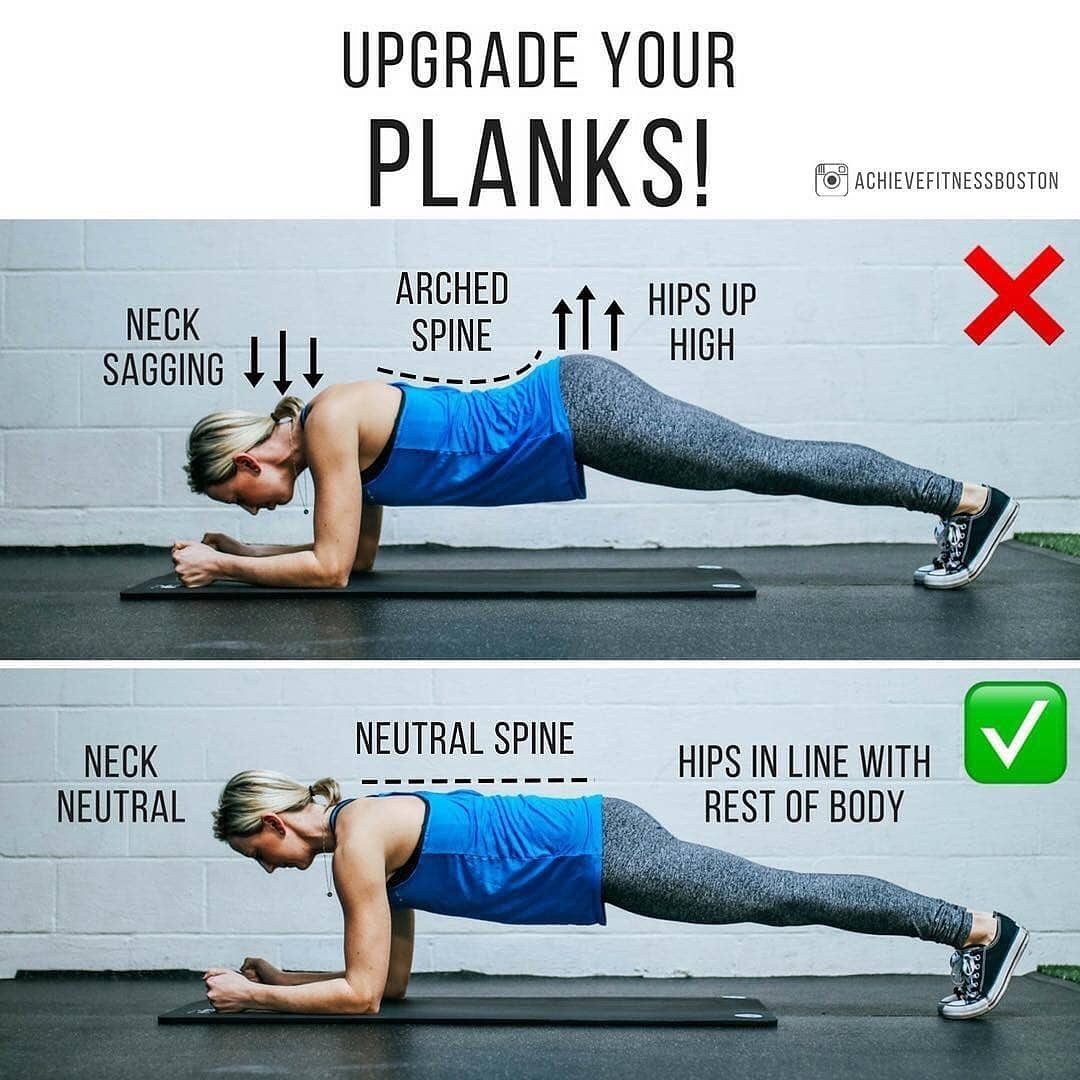
Once you’ve mastered the basic plank, it’s time to explore different variations to challenge yourself and enhance your core strength. Plank variations target different muscle groups, making them a versatile exercise for a well-rounded workout. You can also modify the plank to suit your fitness level and any physical limitations.
Plank Variations
Here are some popular plank variations and their benefits:
| Variation | Description | Benefits | Tips |
|---|---|---|---|
| High Plank | Traditional plank position with hands directly beneath shoulders and body forming a straight line from head to heels. | Strengthens core, shoulders, and triceps. | Engage your core, keep your back flat, and avoid sagging in the middle. |
| Forearm Plank | Similar to the high plank but with forearms resting on the ground, elbows aligned beneath shoulders. | Strengthens core, forearms, and wrists. | Keep elbows directly beneath shoulders, engage your core, and avoid letting your hips sag. |
| Side Plank | Body supported on one forearm and one foot, with the opposite arm extended towards the ceiling. | Strengthens obliques, core, and hip flexors. | Keep your body in a straight line, engage your core, and avoid letting your hips drop. |
| Elevated Plank | Performed with hands or forearms elevated on a bench or box, increasing the challenge. | Strengthens core, shoulders, and triceps, enhances stability. | Maintain a straight line from head to heels, engage your core, and avoid arching your back. |
| Plank with Leg Raise | Starting in a high plank position, lift one leg off the ground, keeping it straight and aligned with your body. | Strengthens core, hamstrings, and glutes. | Maintain a stable plank, avoid swaying your hips, and alternate legs. |
| Plank with Arm Reach | Starting in a high plank position, extend one arm forward, keeping it straight and aligned with your body. | Strengthens core, shoulders, and triceps. | Maintain a stable plank, engage your core, and avoid arching your back. |
| Plank with Knee Drive | Starting in a high plank position, bring one knee towards your chest, keeping your core engaged. | Strengthens core, hips, and glutes. | Maintain a stable plank, avoid arching your back, and alternate legs. |
Plank Modifications
For beginners or individuals with specific physical limitations, modifications can make the plank more accessible:
- Modified Plank on Knees:Instead of resting on your toes, rest on your knees. This reduces the strain on your wrists and core, making it easier to maintain proper form.
- Wall Plank:Perform the plank with your hands against a wall, using your body weight to lean against the wall. This allows for greater control and reduces the strain on your core.
- Plank with Support:Use a pillow or rolled-up towel under your forearms or hands to provide support for your wrists and reduce strain.
- Shorten Hold Time:Begin with shorter plank holds and gradually increase the duration as your strength improves.
Incorporating the Plank into a Workout Routine
The plank is a versatile exercise that can be integrated into various workout routines, depending on your fitness goals. It’s a great way to build core strength, improve posture, and enhance overall stability. Here’s how to effectively incorporate the plank into your workout program:
Plank-Based Routines for Different Fitness Goals
You can tailor your plank workouts based on your specific fitness objectives. Here are some examples:
Building Core Strength
- Start with a basic plank hold for 30-60 seconds, gradually increasing the duration as you get stronger. Aim for 3-4 sets.
- Include variations like the side plank, forearm plank, and high plank to target different core muscles.
- Add dynamic movements like plank jacks or plank toe taps to challenge your core further.
Improving Posture
- Focus on maintaining proper form during your plank holds. Ensure your body forms a straight line from head to heels.
- Incorporate the plank into your daily routine. Try holding a plank for 30 seconds while watching TV or waiting for the kettle to boil.
- Include exercises that target the back muscles, such as rows and pull-ups, to complement your plank training.
Enhancing Overall Stability
- Include planks in your warm-up routine to activate your core muscles before more demanding exercises.
- Perform planks after strength training exercises to target your core and improve overall stability.
- Consider incorporating planks into functional exercises, such as lunges or squats, to challenge your balance and coordination.
Progressive Overload and Proper Rest
Progressive overload is a fundamental principle in fitness training. It involves gradually increasing the challenge of your workouts to stimulate muscle growth and adaptation. Here’s how to apply this principle to plank training:
- Increase the duration of your plank holds over time. For example, start with 30 seconds and gradually increase to 60 seconds, then 90 seconds, and so on.
- Introduce variations that increase the difficulty, such as side planks, forearm planks, or adding weights to your back.
- Ensure you allow adequate rest between sets and workouts. This allows your muscles to recover and rebuild, preventing overtraining and injuries.
Remember to listen to your body and adjust your workouts accordingly. If you experience any pain, stop and consult a healthcare professional.
End of Discussion
By understanding the common mistakes and implementing the corrective measures Artikeld in this article, you can unlock the full potential of the plank exercise. Remember, consistency and proper form are key to building a strong core and achieving your fitness goals.
So, embrace the plank, avoid the pitfalls, and enjoy the journey towards a healthier and stronger you.


